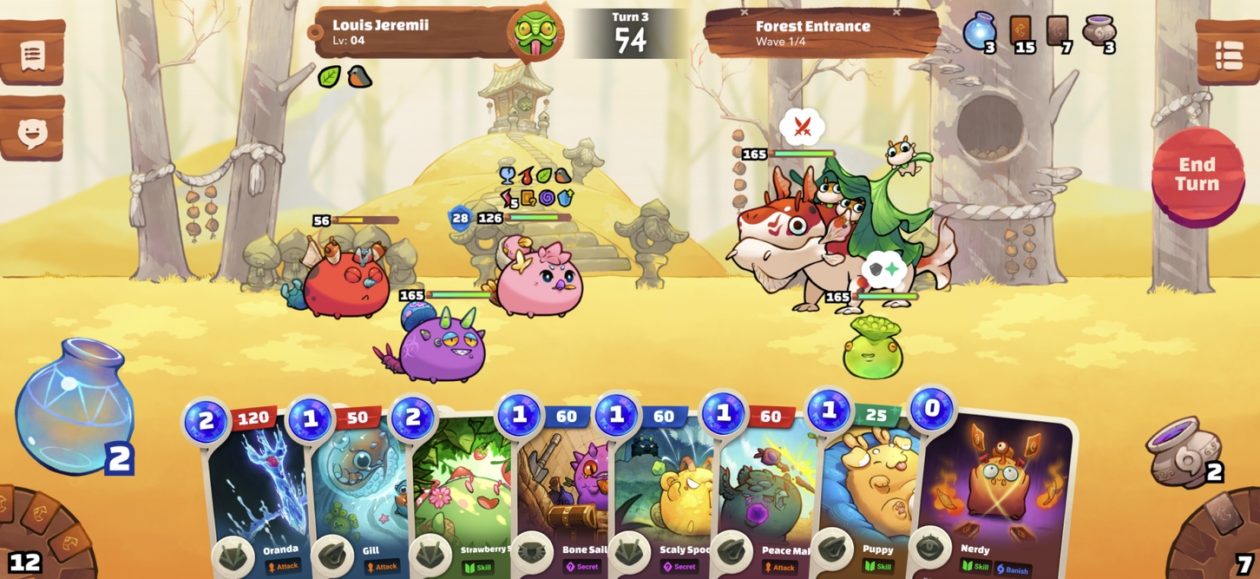The relatively nascent play-to-earn gaming industry is looking to add more fun to its titles in an effort to attract hardcore gamers and grab a slice of a market that is estimated to be worth more than half a trillion U.S. dollars by 2028.
“If you look at the growth of GameFi (Game Finance) from last year to now, most of these GameFi are still not really games,” MetaOne Global Inc. chief executive officer Marrtin Hoon told Forkast. “Their focus is on Fi (finance),” said the chief executive officer of the Singapore-based platform that helps onboard massive multiplayer games and guilds onto blockchain gaming.
Hoon’s comments come as the play-to-earn gaming industry suffers from growing pains.
Though not constantly engaging, industry pioneer Sky Mavis Pte. Ltd.’s non-fungible token game Axie Infinity attracted 2.7 million weekly users at its peak in mid-November, according to cofounder Jeffrey Zirlin.
“The reason why play-to-earn (P2E) games have not been sustainable to date is that the supply and demand within the ecosystem was not properly designed and was solely funded by the initial investment from new users,” Daiki Moriyama, director of blockchain-based game infrastructure firm Oasys told Forkast.
One way game developers can encourage players to buy tokens is through in-game purchases, Moriyama said.
Fool’s paradise
However, the earning model can be a double-edged sword. As demand for Axies — the digital assets required to play the game — and the pace of growth in the number of users slowed, the supply of Axie Infinity’s in-game currency, known as Smooth Love Potion, or SLP, began to outpace demand, leading to a drop in its price.
From a peak of US$0.3642 in May 2021, the price of SLP has fallen to US$0.0038 in afternoon trade in Asia on Friday, according to data from CoinMarketCap.
GameFi incentivized players by supplying tokens, and the demand was weak, Moriyama said. Blockchain-based games in the future will need to strike a balance between supply and demand of such tokens when building their tokenomic models, he added, referring to the understanding of the supply and demand characteristics of cryptocurrencies.
The drop in token prices has also meant players are earning a lot less than before, prompting many to quit playing.
Albert Takagi, Axie Infinity’s Japan Ambassador or community builder, told Forkast that at least a third of Filipino gamers in a guild he owns have left for other day jobs, with most remaining players no longer playing full-time.
In April, Sky Mavis soft-launched Axie: Origin, a long-awaited upgrade that goes with the approach of “play-and-earn” rather than a “play-to-earn” model, where players can earn crypto rewards by playing video games.
Philip La, who leads game products at Sky Mavis, wrote in a blog post on Sunday that the developer is aware of economic imbalances.
“That is a major area Origin was built to bring balance to with the introduction of more ways for players to spend on things they value. It will evolve the Axie Infinity model so it is not player growth-dependent,” La wrote.
“There will definitely be a material impact on GameFi because it was focusing on Fi,” Hoon said. “But moving forward, this bad situation is very, very useful for infrastructure developers like us.”
The GameFi industry attracted lots of players from the decentralized finance community due to its focus on earnings, Hoon said. But moving forward, blockchain infrastructure developers are looking to wean away gamers from traditional titles, he added.
Even a sliver of the global gaming market will reap huge dividends for the P2E industry.
The global gaming market is estimated to grow from US$229.16 billion in 2021 to US$545.98 billion in 2028, according to Fortune Business Insights, a market research firm.
“Gamers are prepared to take risks,” Hoon said. “They do in-game purchases but the game must be fun for them to do so.”
In it to win it
The market value of in-game purchases is estimated to surpass US$74.4 billion in 2025, according to Jessica Clement, team lead for research on internet and gaming at consumer and market research firm Statista. Gamers spent an estimated US$54 billion on in-game content in 2020, she said.
The sticking power of gaming revenue is attracting Big Tech already. In January, Microsoft Corp. said it will acquire Activision Blizzard, the developer of titles such as “Warcraft,” “Diablo,” “Overwatch,” “Call of Duty” and “Candy Crush,” in addition to global eSports franchises such as Major League Gaming, for US$68.7 billion in cash.
Gaming is now the largest and fastest-growing form of entertainment with an estimated three billion people playing the game, Microsoft said.
Over the past 20 years of economic turmoil, the traditional gaming industry has been “war-proof, recession-proof and virus-proof,” Hoon said. “GameFi should be following the same because the fundamentals have to be back on the game,” along with the benefits of decentralization, Hoon said.
See related article: Play to live: GameFi drives a Southeast Asian crush on crypto
Meanwhile, Origin has done relatively well despite initial reservations by loyalists.
Sky Mavis recorded about 30,000 installs for Origin over the past week, the company told Forkast on Friday. When the game came out in April, it saw over 500,000 installs within the week.
“If you look at the last two months, Origin has kind of improved in its gameplay lately,” said Gabby Dizon, cofounder of Yield Guild Games (YGG), a pioneer of gaming guilds in the Philippines. “It’s a lot more fun now,” Dizon said, adding that the game studio is making sure playing the game is as fun as possible to make it sustainable.
“This has, of course, meant that they have taken a short-term hit in the user base,” Dizon said. “I really believe in the future of Axie Infinity.”
See related article: Axie Infinity’s latest fix to tokenomics has players up in arms
Another avenue to make profits could come from electronic sports or esports, Dizon said.
“One of my personal theses is that play-to-earn and esports worlds are merging and will be the same in the next five years,” Dizon said, adding that the game format lends itself to tournaments and promoting professional players, helping extend the longevity of the game.
In fact, YGG is in talks with partners in the hope of launching a SubDAO, a smaller, autonomous working group within a broader DAO, in South Korea, where esports thrive.
“The Koreans have some of the best gamers in the world — the best esports teams and athletes,” said Dizon. “So the Korean subDAO [under planning] would be very focused on esports.”
At the end of the day, the core gameplay itself “has to be fun” for people to stick around and to spend money in the economy, Dizon added. “That’s what will make the game last.”





